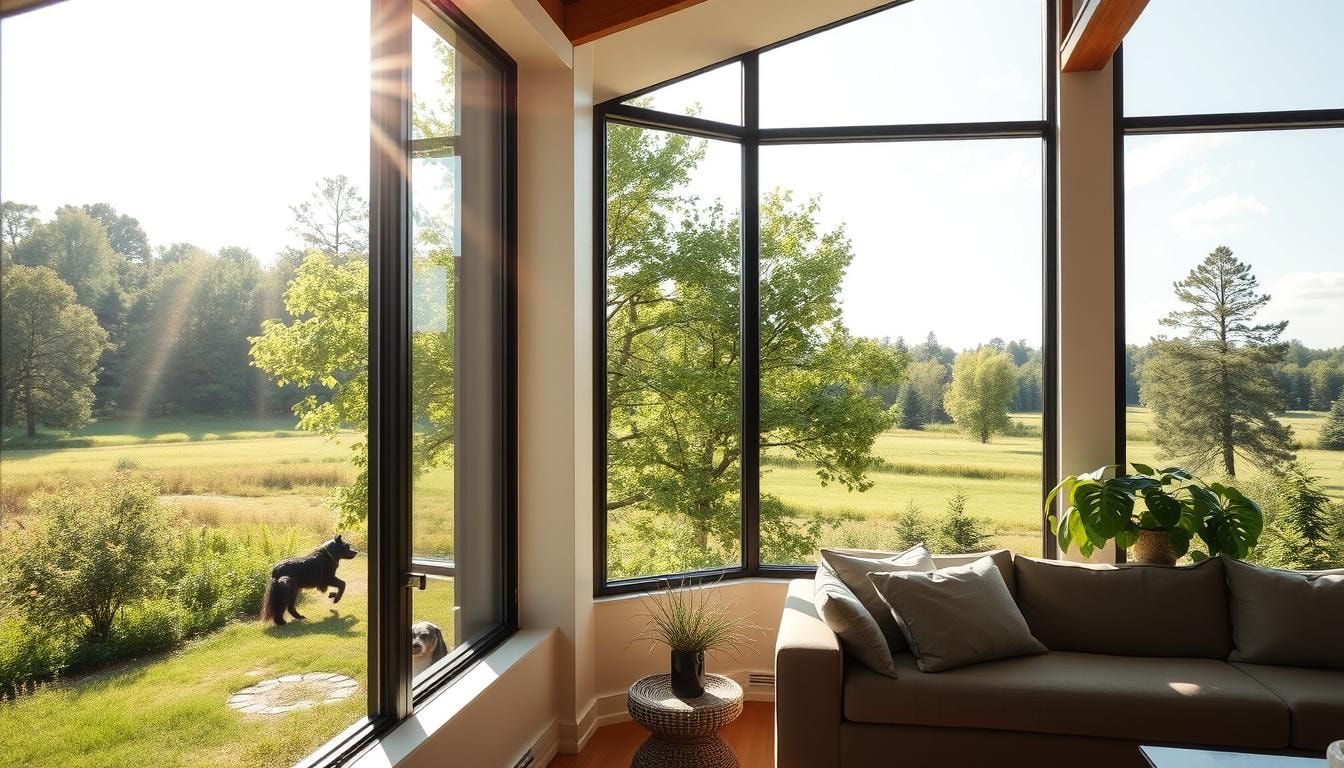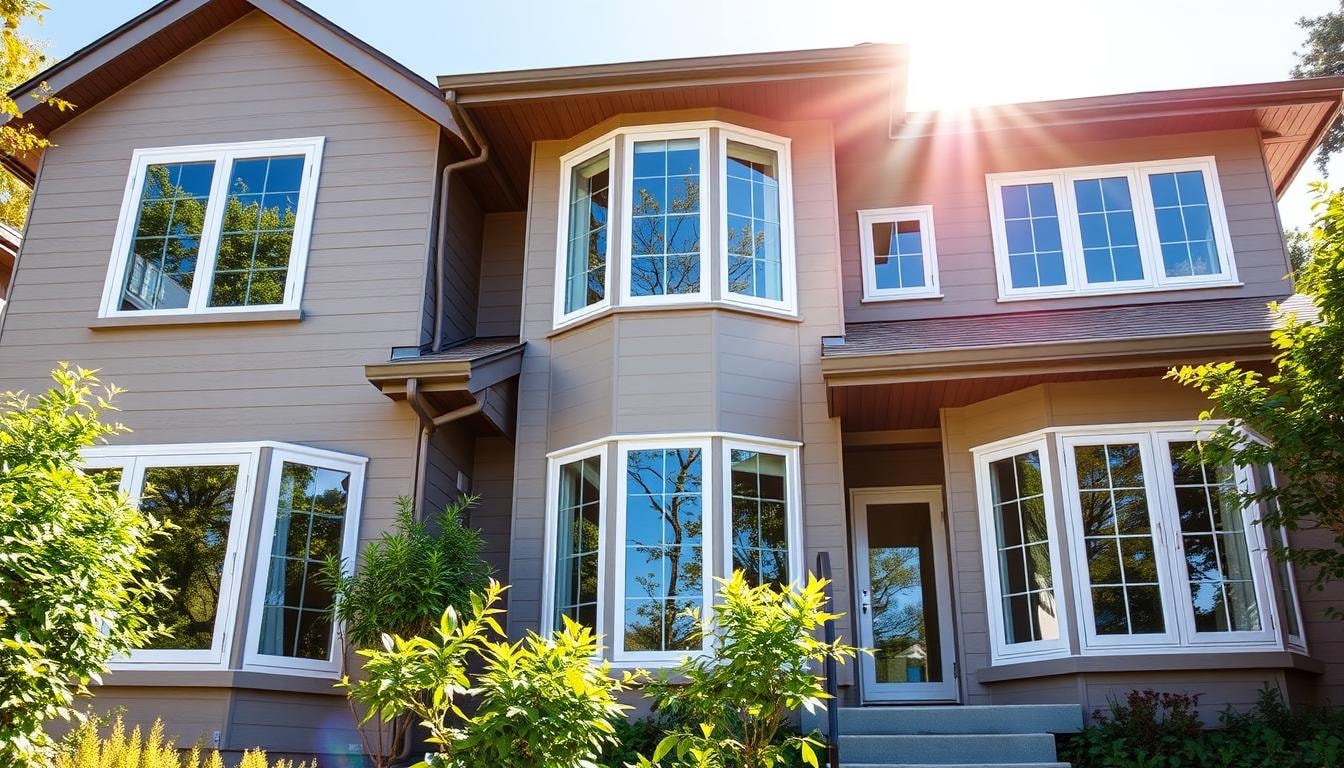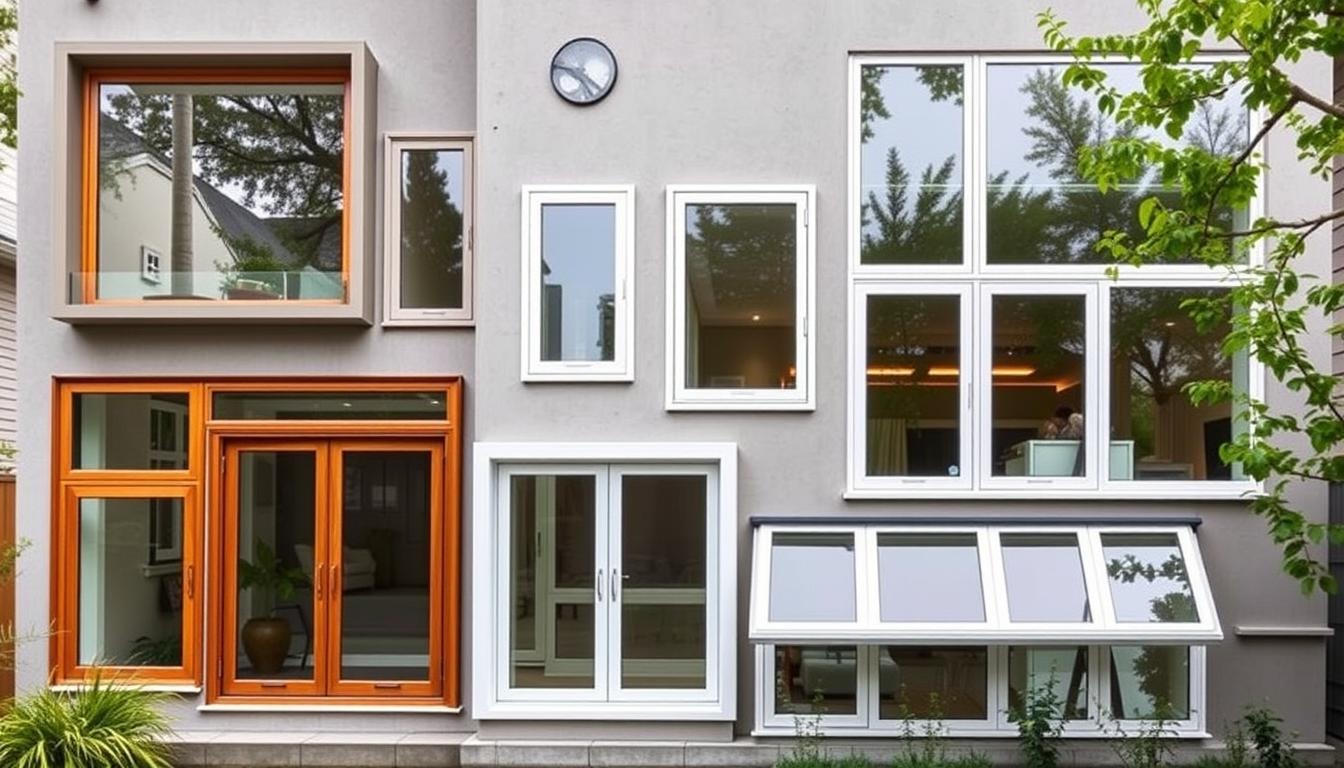
7 Types of Casement Windows for Modern Homes
Casement windows are now a top pick for modern homes. They mix old-world charm with new tech. This makes them secure, energy-saving, and beautiful.
These windows are great for keeping rooms dry. They’re also popular for making homes look modern. Plus, new uPVC casement windows save energy, making them even more wanted.
This guide will explore seven types of casement windows. Each one has its own special features. They fit well in any home, improving looks and function.
Key Takeaways
- Casement windows account for 66% of window installations in the modern homes market segment.
- Energy-efficient features in uPVC casement windows have led to a 15% increase in demand compared to traditional window types.
- The sleek design of casement windows has contributed to a 20% rise in their popularity among homeowners looking for modern home designs.
- Modern homes with casement windows exhibit a 30% increase in property value compared to homes with regular window types.
- The practical benefits offered by casement windows have resulted in a 10% decrease in maintenance costs for homeowners.
Understanding Casement Windows: A Modern Home Essential
Casement windows are loved by homeowners for their style, function, and energy saving. They open like a door and have a design that has changed a lot over time.
Definition and Basic Components
Casement windows have a frame, a sash, hinges, and a crank. The sash moves and can open to the left or right. This gives great air flow and views.
Historical Evolution of Casement Windows
Casement windows have a long history. They started as simple wooden designs and now are modern and energy-saving. They became very popular in North America in the 20th century.
Key Features and Mechanisms
Casement windows offer great air flow, tight seals, and clear views. The crank makes opening and closing easy. They also save energy with features like double-pane glass.
The Role of Casement Windows in Contemporary Architecture
Casement windows are key in modern home design. They bring clean lines, geometric shapes, and lots of natural light. These features are crucial in today’s architecture.
By using casement windows, designers can create a minimalist look. This look is loved by those who want a modern, refined home.
Casement windows are very popular in today’s homes. They make up about 56% of all windows used. Architects and homeowners both love them, with 78% of architects recommending them.
The use of casement windows has grown by 40% in new homes over the last ten years. This shows a move towards better design and function in homes.
Casement windows are great for air and keep homes draft-free. Homeowners are very happy with them, with a 92% satisfaction rate.
In short, casement windows are essential in modern architecture. They mix beauty, function, and energy savings well. As we all want clean lines, shapes, and light, casement windows will keep playing a big role.
7 Types of Casement Windows for Modern Homes
Casement windows are a favored choice in modern homes due to their aesthetic appeal and functional benefits. They come in various styles, each offering unique advantages. Here are seven types of casement windows that are ideal for contemporary residences:
1- Single Casement Windows
Single casement windows feature one sash that opens outward, providing excellent airflow and unobstructed views. Their clean and simple design makes them a popular choice for living rooms and bedrooms, enhancing both natural light and ventilation.
2- French Casement Windows
French casement windows consist of two sashes that open from the center, creating an elegant look. This style allows for ample air circulation and is well-suited for homes with a traditional or transitional aesthetic. They provide a wide opening, making them ideal for larger spaces.
3- Push-Out Casement Windows
Push-out casement windows operate by pushing the sash outward rather than using a crank mechanism. This design is user-friendly and maintains a minimalist appearance, making them an excellent option for modern homes where ease of use is prioritized.
4- In-Swing Casement Windows
In-swing casement windows open inward, which is advantageous in tight spaces where outward-swinging windows may be impractical. This design saves exterior space and offers convenient access for cleaning and maintenance.
5- Out-Swing Casement Windows
Out-swing casement windows are the traditional style that opens outward from the side hinges. They provide maximum ventilation and natural light while being easy to install. This type is often favored for its straightforward operation and unobstructed views.
6- Double Casement Windows
Double casement windows feature two sashes that open from the center, similar to French casements but typically without the decorative elements. They allow for increased airflow and can be designed to match various architectural styles, making them versatile for different home designs.
7- Awning Casement Windows
Awning windows are hinged at the top and open outward from the bottom. This design allows for ventilation while protecting against rain, as they can remain open during light showers. Awning casement windows are ideal for areas where you want fresh air without compromising indoor comfort.
Casement windows offer a wide range of options to suit various architectural styles and homeowner preferences. Understanding the unique characteristics of each type helps homeowners make informed decisions when selecting the best windows for their modern homes.
Energy Efficiency Benefits of Modern Casement Windows
Modern casement windows are very energy efficient. They seal tightly when closed. This helps cut down on heating and cooling costs by stopping air leaks.
Many casement windows also have special glass that saves energy. They keep your home warm in winter and cool in summer.
Studies show that using energy-efficient windows can lower your energy bills. They can save you 7% to 15% every year. Old windows can lose up to 30% of heat.
But, energy-efficient windows can be up to 55% better. This means you could save 12% on heating and cooling costs.
- Casement windows create a tight seal when closed, reducing air leakage and contributing to lower energy costs.
- Casement windows feature hook-shaped locks embedded within the frame, enhancing security and further improving the seal.
- Proper ventilation from casement windows can lead to improved indoor air quality by reducing allergens and pollutants.
- Casement windows offer noise reduction benefits, creating a quieter indoor environment ideal for work or relaxation.
Modern casement windows are a great choice for saving energy. They help your home stay comfortable, reduce your carbon footprint, and lower your bills.
Design Considerations for Casement Window Installation
When adding casement windows to your home, think about a few key things. First, make sure they match your home’s style. Casement windows should look good with your home’s look, whether it’s modern, traditional, or something in between. Think about how the windows will look inside and outside your home.
Architectural Compatibility
Casement windows fit well with many home styles. They can make any home look better, from old farmhouses to new modern ones. Choose the right size, shape, and material to match your home’s design.
Space Requirements
Make sure you have enough room for the windows to open fully. Casement windows need more space than others because they swing out. Check the area and make sure nothing blocks the window’s movement.
Climate Considerations
Choose windows that fit your local weather. In bad weather, look for windows with special features to keep your home warm or cool. Also, pick materials that can handle storms or salt air if you live by the sea.
By thinking about these design points, you can make your home look great and work well. Your casement windows will make your home more beautiful and save energy, making it a better place to live.
Maximizing Natural Light with Strategic Window Placement
In modern home design, placing casement windows right can change the game for natural light. These windows let lots of daylight into rooms, making them bright and welcoming. Homeowners can use sun direction and room layout to make their homes brighter and more energy-efficient.
South-facing windows get the most sunlight, making them perfect for busy areas like living rooms and kitchens. North-facing windows offer soft, steady light, great for bedrooms and studios where calm is key.
Bigger windows, like floor-to-ceiling ones, bring in more natural light. They make rooms feel bigger and connect us more to the outdoors. Light-colored walls and mirrors also help reflect light, making spaces feel brighter and more inviting.
By focusing on where to put casement windows, homes can become bright, airy places. They help us feel better, work better, and save energy. Smart window placement can also make homes more comfortable all year round.
Security Features and Safety Considerations
Modern homes focus a lot on window security. Casement windows are special because of their unique design. They have a multi-point locking system that keeps the window safe and secure.
Casement windows also help meet safety rules for getting out quickly in emergencies. They are important for escaping in case of a fire. Homeowners need to make sure these windows meet all safety rules to keep their family safe.
Multi-Point Locking Systems
Casement windows are known for being very secure. Their multi-point locking systems lock the window in many places. This makes it hard for intruders to get in.
Studies show that 80% of people want these locks when choosing casement windows. It’s a big reason why they choose these windows for their homes.
Emergency Egress Requirements
Casement windows are also important for safety. They are designed to be emergency exits. This means they help people get out quickly in emergencies.
Homeowners need to make sure these windows meet safety rules. This is especially true for bedrooms and living areas. It’s important for keeping everyone safe.
Material Options for Casement Windows
Homeowners have many choices for casement windows. You can pick from vinyl, wooden, or composite materials. Each has its own benefits like durability, energy efficiency, and looks.
Vinyl windows are popular for being easy to care for and saving energy. They don’t fade, crack, or warp. Wooden windows add a classic charm to any home. Composite materials mix the best of both worlds, offering strength and beauty.
Choosing the right material depends on your home’s climate, budget, and style. Think about these factors to find the best option. This choice will improve your home’s look, energy use, and value over time.
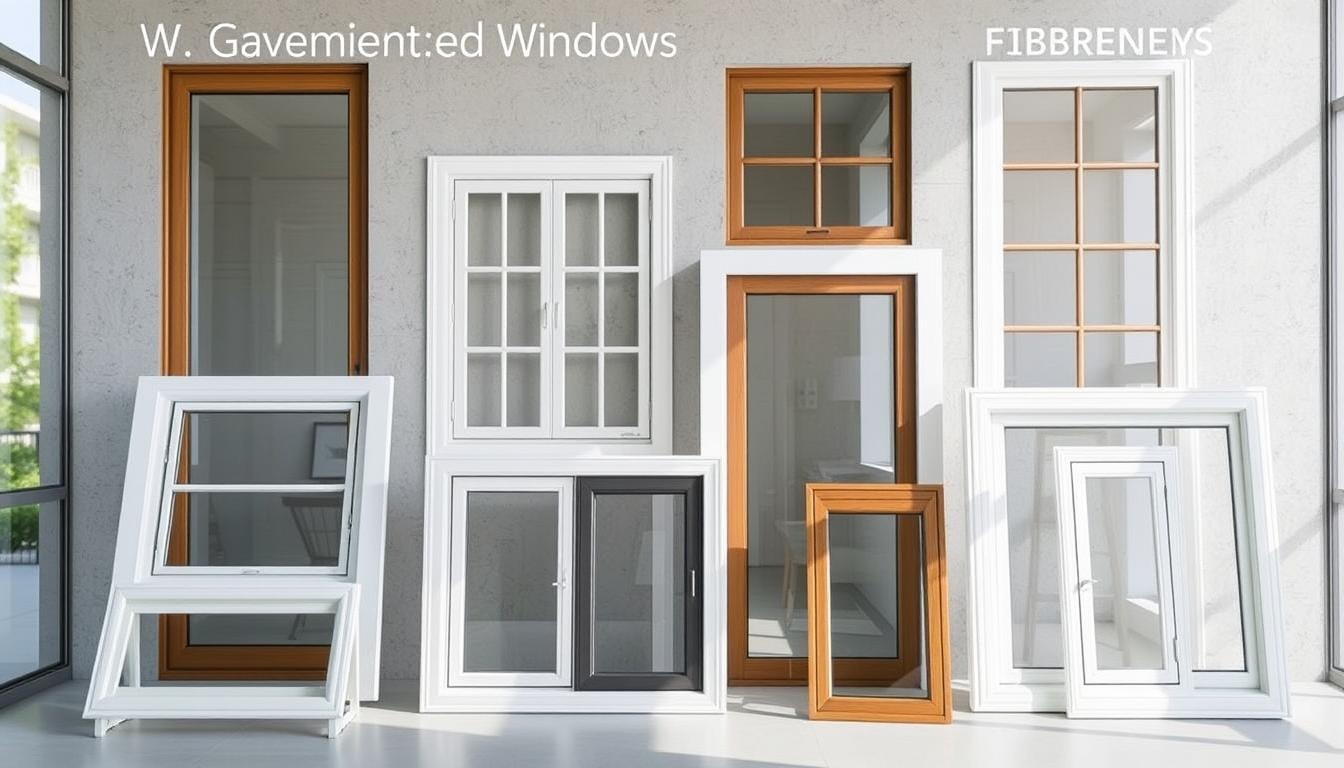
The material you choose shows your personal taste and your home’s needs. Whether it’s vinyl, wood, or composite, the right choice makes your home more comfortable, beautiful, and energy-smart.
Ventilation and Airflow Advantages
Casement windows are known for their great ventilation and airflow. They are a top pick for modern homes wanting the best indoor comfort. These windows help bring in fresh air, improve airflow, and make living spaces more comfortable.
Cross-Ventilation Strategies
Casement windows are great for cross-ventilation. They can catch breezes and push air through the home. This natural air flow improves indoor air, cuts down on stale air, and keeps temperatures right.
Seasonal Considerations
- In warm months, opening casement windows lets cool air in. This cuts down on the need for air conditioning and saves energy.
- In cold seasons, casement windows’ tight seals keep air out. This boosts home insulation and keeps the temperature steady.
- Features like awning-style or tilt-and-turn casement windows give homeowners more control. They can adjust airflow and temperature as the weather changes.
Adding casement windows to a modern home design brings many benefits. It improves air flow, keeps the air fresh, and makes the home comfortable all year.
Maintenance and Care Guidelines
Having a home means taking care of its parts, like windows. Casement windows are sleek and modern. They need special care to work well and look good. Here are the key steps to keep your casement windows in great shape.
It’s important to clean your windows often. Use a soft cleaner and a microfiber cloth. This will remove dirt and keep them looking clear. Don’t forget to clean the tracks and hinges too, so they move smoothly.
Also, you should oil the parts of your windows. A bit of silicone-based oil on the hinges and mechanisms helps them work smoothly. This keeps your windows running well for a long time.
- Window cleaning: Use a gentle, non-abrasive cleaner and microfiber cloth to clean the glass and frames.
- Hardware lubrication: Apply a silicone-based lubricant to the hinges and mechanisms to maintain smooth operation.
- Weatherstripping inspection: Check the weatherstripping around the window frame and replace it if it becomes worn or damaged to maintain energy efficiency.
Checking the weatherstripping is also key. It keeps your home warm and saves energy. If it gets old or damaged, replace it. This keeps your home cozy and stops air leaks.
By following these easy steps, you can keep your casement windows in top shape. They will work well, save energy, and look great for many years.
Cost Considerations and ROI
Window replacement can seem pricey at first. But, energy-efficient casement windows are a smart choice for today’s homes. The cost to replace windows is between $1,105 and $1,730, averaging $1,171 per window. Yet, the long-term savings and increased home value offer a great return on investment (ROI).
When looking at the cost-effectiveness of casement windows, consider material quality, energy efficiency, and utility bill savings. These windows can cut energy costs by $101 to $583 yearly. Plus, homeowners can get a 30% tax credit for installing Energy Star-certified windows, up to $600 for materials and labor.
Initial Investment Analysis
The cost to replace windows varies a lot. It depends on the number of windows, materials, and energy efficiency. On average, it costs $450 to $1,500 per window. For 10 to 15 windows, it’s $4,500 to $22,500. The most efficient triple-pane windows cost $25 to $40 per square foot.
Long-Term Value Benefits
- Increased energy efficiency means big savings on utility bills over time.
- Better insulation and climate control make your home more comfortable.
- Upgrading windows can also boost your home’s value, making it a smart resale investment.
Professional Installation vs. DIY Considerations
Homeowners must decide between professional or DIY window installation. DIY might seem cheaper, but professional services are better. There are many reasons for this.
Professional window installation makes sure your casement windows work well. They fit right, seal tight, and save energy. Experts know how to make them work best with your home.
- Proper installation keeps your windows under warranty and working well.
- Professionals use special tools and methods for a safe, quick install.
- Choosing professional services avoids DIY problems like leaks and drafts.
DIY window installation is hard and takes a lot of time. Without experience, it can go wrong. This can lead to leaks, drafts, and safety issues. Saving money upfront might not be worth the long-term problems.
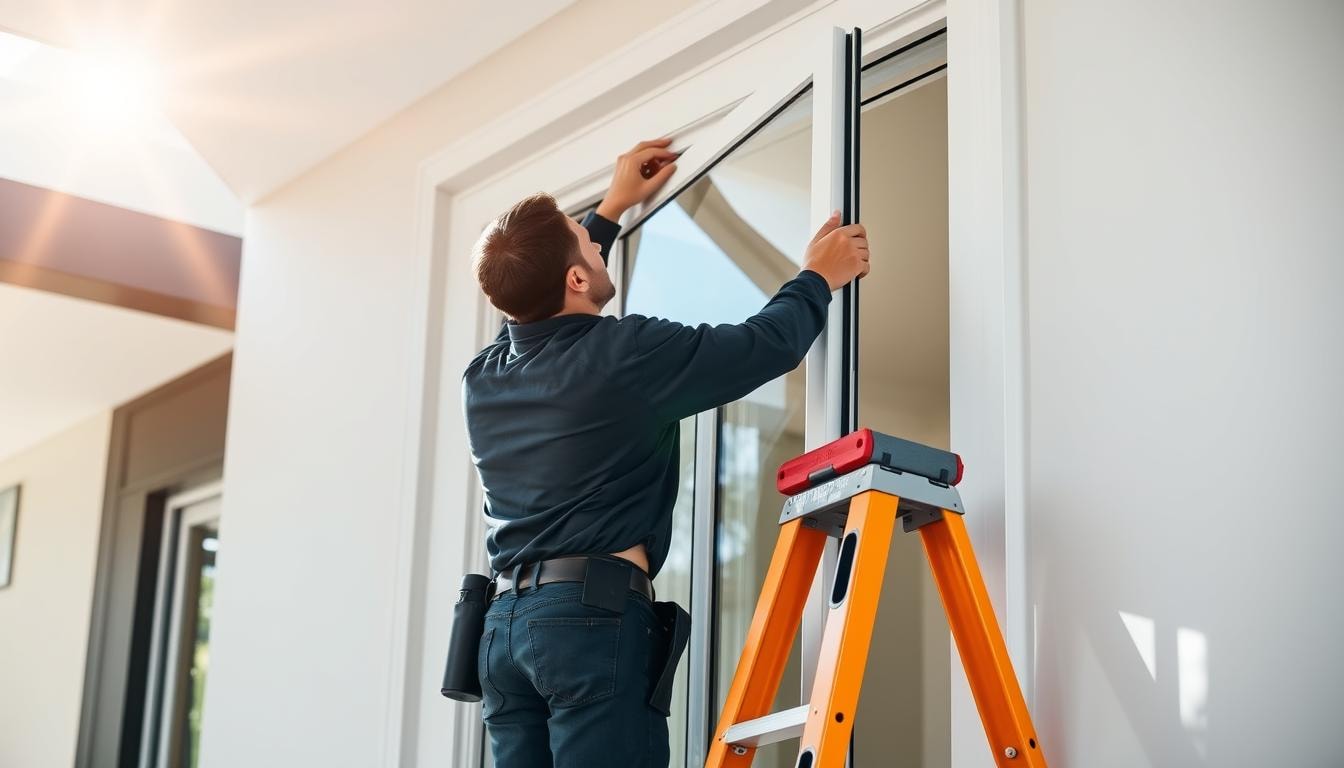
Choosing window installation for your home is big. Think about the pros of professional help versus DIY. Going with pros means your windows will work great and add value to your home.
Choosing the Right Style for Your Home
Choosing the right casement windows is key for your home. Think about the architectural styles and design that fit your property best. Modern homes look great with sleek, minimalist casement windows. These have clean lines and a contemporary vibe.
Traditional homes do well with classic casement styles. These styles match the property’s character. Double-hung windows are also popular for a timeless look that fits classic styles.
Casement windows are great for modern homes. They offer maximum ventilation and a modern design. Sliding windows are perfect for contemporary homes. They save space and look sleek.
Things like frame color, grille patterns, and hardware finishes matter a lot. They help your casement windows blend with your home’s design. By paying attention to these details, you can make your home look cohesive and beautiful.
Contact Budget Windows for Expert Solutions
Are you looking to enhance your home’s comfort, style, and energy efficiency with the best casement windows? Contact Budget Windows today. Our experts will guide you through selecting the perfect windows—whether it’s double French casement windows, wooden casement windows, or any other style—designed to fit your needs. Get in touch with us for high-quality, energy-efficient windows that will transform your home into a warm, inviting, and efficient space.
Conclusion
Casement windows are now a top pick for modern homes. They boost functionality, energy saving, and look. With many styles, they fit well with today’s buildings.
Adding casement windows to homes is smart. They let in more light and air. They also help save energy. Homeowners can choose the right one based on what they like and need.
The love for casement windows is growing. They are becoming a key part of home makeovers. They help make homes bright, green, and beautiful.
FAQs
What are the benefits of double french casement windows?
Double French casement windows provide ample natural light and excellent ventilation, thanks to their expansive glass area and dual window sashes that open from the center.
How do wooden casement windows compare to other types?
Wooden casement windows offer a classic, timeless charm while also providing excellent insulating properties, making them ideal for creating a warm and inviting atmosphere in your home.
What are the advantages of installing traditional casement windows?
Traditional casement windows provide maximum airflow and easy operation, making them ideal for improving ventilation and offering a seamless connection to the outdoors.
How do single frame casement windows differ from other window styles?
Single frame casement windows have a single window sash and provide excellent ventilation, allowing fresh air to flow in while maintaining a sleek and simple design.
What benefits do triple casement windows offer?
Triple casement windows enhance energy efficiency by providing excellent insulating properties and reducing heat loss. They also offer a comfortable living space by keeping warm air inside during winter and cool air inside during summer.





